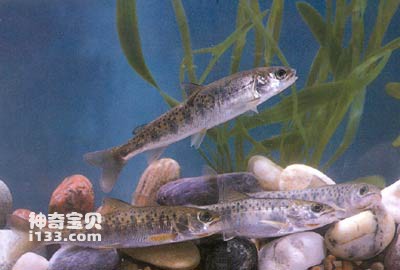Brachymystax lenok belongs to the order Salmoniformes, family Salmonidae, and genus Brachymystax lenok. Commonly known as: mountain fine fish, river fine fish (Northeast), Lu fish, Lu flower fish, golden plate fish, flower fish (Shaanxi), plum blossom fish (Gansu), small red fish (Xinjiang). English name: Lenok.
It is named because of its small scales. The body is long, the sides are flat, the head is slightly pointed, and the snout is blunt. The mouth is small, transversely cleft, and subinferior; the maxilla is obvious and free, extending backward to the center of the eye below. There are inward-inclined teeth on the upper and lower jaws, vomer bones, palatine bones, and tongue. The eyes are large, the scales are small, and the adipose fin is small. There are 63-91 pyloric caeca, with dark brown back and reddish brown sides, with irregular black spots distributed. Juvenile fish have several vertical dark lines. The abdomen is silvery white. Body color varies depending on the water in which it lives. The group that inhabits mountain streams all year round has a greenish-brown back, darker sides, and a white belly. The dorsal fin, anal fin, and adipose fin have black spots with black outer edges; the pectoral and pelvic fins are orange-red with black spots. The individual is small, with a body length of less than 350 mm. Fishermen call it "Mountain Thin Scale". The fine-scaled fish that migrates to rivers to overwinter in winter is large in size, with a black-green back, yellow-brown sides, black spots, and a black abdomen; the front corner of the dorsal fin is black; the pectoral and pelvic fins are green-brown; the tail fin has slender black spots and black edges. ; Brighter than the former, commonly known as "Jiang Xinlin". During the reproductive season, adult fish are dark in color, the front rays of the dorsal fin turn black, and faint red spots appear on the sides of the body. The body color changes greatly at different ages and in different habitats. Generally, the body color of older fish is darker than that of young fish.

The squid is a cold-water fish that mostly inhabits flowing water with low water temperature and clear water quality. In winter, it overwinters in the deep ponds of tributaries or large rivers. The young fish burrow into stone crevices or piles of rocks to overwinter. In early spring, when the rivers thaw, they migrate upstream from the middle reaches of the river to spawn. Before freezing in autumn (after August), they migrate from upstream streams to rivers or rivers. Sexual maturity occurs at 3-5 winter years, and the body length is about 420 mm. Spawning occurs from mid-April to June, when the water temperature is 4-12°C. The eggs are laid at the lower end of the river or the whistle with clear water quality and slow flow of gravel bottom. A large number of brood fish die after breeding, especially male fish. The larvae like to lurk in the gaps between the gravel and rarely swim. They usually feed on small fish, aquatic insects, small animals living on the shore, and plants. It is extremely voracious, and the food in its stomach can account for about 10% of its own body weight. It can even prey on fish that are half the size of its own body. The times when the appetite is strongest every day are in the morning and evening. At other times, they usually lurk at the bottom of the shaded water on both sides of the stream. The appetite is particularly strong after laying eggs.
In my country, it is distributed in the upper reaches of the Hun River, a tributary from Heilongjiang to the Liao River, the upper reaches of the Chaobai River and Luan River in Hebei and Inner Mongolia, the upper reaches of the Wei River and its tributaries of the Yellow River, and the upper reaches of the Shuzi River and Ziwu River, the northern tributaries of the Han River in the Yangtze River. Abroad, it is found in rivers in eastern Russia, North Korea, and parts of Mongolia.
It is an important economic fish in the Heilongjiang Basin. The meat is plump, with high fat content (3.8-7.7%), and the body is large, generally weighing 1 kg, and the largest individual can reach 8 kg. In addition, eggs are also quite expensive.
animal tags:
We created this article in conjunction with AI technology, then made sure it was fact-checked and edited by a Animals Top editor.